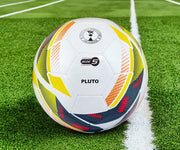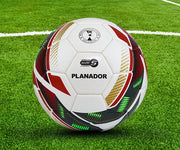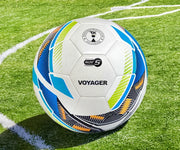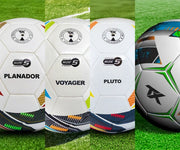Football (or soccer) is the world’s most popular sport, played across all age groups in schools, clubs, and professional leagues. Whether you're a beginner, a coach, or an experienced player, choosing the right football size is essential for skill development, performance, and safety. Using the wrong ball can make it harder to control, pass, or shoot, affecting the overall gameplay. Wondering how to choose the right football size? This FIFA-level guide will help you understand the different dimensions, their official regulations, and factors to consider when purchasing.
Understanding Football Sizes
Dimensions are categorized based on age groups, skill levels, and match regulations. FIFA and other governing bodies have standardized these to ensure fair and consistent play across different levels of the game.
Official FIFA-Recommended Dimensions
| Size | Circumference (inches) | Weight (grams) | Recommended Age Group | Usage |
|---|---|---|---|---|
| 1 | 18–20 | 200–280 | All ages (mainly toddlers) | Skills training, souvenirs |
| 2 | 20–22 | 250–280 | Under 4 years | Ball control improvement |
| 3 | 23–24 | 300–320 | 4–8 years | Junior football matches |
| 4 | 25–26 | 350–390 | 8–12 years | Youth football, training |
| 5 | 27–28 | 410–450 | 13+ years (adults) | Professional and competitive matches |
The normal dimension used in professional games is 5, which meets FIFA’s regulations for circumference, weight, and inflation.
How to Choose the Right Football Size
1. Consider the Player’s Age and Skill Level
-
Toddlers & Young Kids (Under 4 years) → 1 or 2 for fun and basic coordination.
-
Children (4-8 years) → 3 to develop dribbling and passing skills.
-
Youth Players (8-12 years) → 4 to prepare for the transition to full-sized play.
-
Teenagers & Adults (13+ years) → 5, the standard for competitive play.
If you’re wondering what size soccer ball for adults is best, 5 is the only official choice for professional matches.
2. Determine the Type of Play
-
Casual Play: For recreational games, any ball that feels comfortable works.
-
Training & Skill Development: Coaches use smaller balls ( 1 or 2) for dribbling drills.
-
Professional & Competitive Matches: Only 5 are approved for official games.
3. Choose the Right Ball Based on Playing Surface
-
Grass Fields: Traditional FIFA-approved leather ones work best.
-
Indoor Courts: Futsal ones ( 4, low bounce) are ideal for quick play.
-
Artificial Turf: Synthetic leather ones resist wear and last longer.
What is the Regulation Soccer Ball Size?
FIFA and official governing bodies, such as UEFA, mandate that s:5 is the regulation soccer dimension for professional matches. They must meet these criteria:
-
Circumference: 27–28 inches
-
Weight: 410–450 grams
-
Proper Inflation: 8.5–15.6 PSI
All major leagues, including the FIFA World Cup, UEFA Champions League, and English Premier League, use s:5.
Material and Construction of Footballs
The real concern in how to choose the right football size is, that not all are same. Their construction affects durability, feel, and overall performance.
1. Outer Cover Material
-
PU (Polyurethane): High-quality, soft, and used in professional ones.
-
PVC (Polyvinyl Chloride): Budget-friendly but less durable.
-
Leather: Traditional, now mostly used for indoor play.
2. Bladder Type
-
Latex: Provides better bounce and softer touch.
-
Butyl: Retains air longer, good for long-term play.
3. Stitching Method
-
Hand-Stitched: Highest durability, used in professional ones.
-
Machine-Stitched: Good for training but less durable.
-
Thermal Bonding: Seamless, water-resistant, used in top-tier matches.
Additional Factors to Consider When Choosing a Football
Beyond dimension and material, here are a few additional aspects to keep in mind when searching how to choose the right football size:
1. FIFA Quality Marks
Look for FIFA-approved logos, such as:
-
Quality Pro: Highest standard, used in international competitions.
-
Quality: Approved for competitive matches.
-
Basic: Ideal for recreational play.
2. Inflation and Air Retention
Ensure your playing equipment is properly inflated according to manufacturer recommendations. Over or under-inflated ones affect performance and durability.
3. Weather Conditions
-
Wet conditions? Look for water-resistant ones.
-
Hot climates? Avoid leather ones, as they absorb moisture and lose shape.
How to Maintain Your Football
To extend the life of your equipment, follow these maintenance tips:
-
Keep it properly inflated (check the PSI before playing).
-
Store it in a cool, dry place to prevent material damage.
-
Clean it after each use to remove dirt and moisture.
-
Avoid using it on rough surfaces to prevent early wear and tear.
Common Questions About How to Choose the Right Football Size
Q1: Can kids use a Size 5?
While they can, it’s not recommended. Younger players should use Size 3 or 4 for better control and skill development.
Q2: What’s the best size for training?
For skill drills, 1 or 2 is best. For match preparation, youth players should use s:4, and professionals should train with s:5.
Q3: What’s the difference between a futsal ball and a regular one?
A futsal one is smaller (s:4) and has less bounce to suit fast-paced indoor play, whereas a regular one is designed for outdoor fields.
Q4: How often should I replace my equipment?
If well-maintained, good quality can last 1–2 years. However, frequent players may need a replacement sooner.
Selecting the right equipment is essential for improving your skills and enjoying the game. Whether you’re a beginner, youth player, or professional, knowing how to choose the right one ensures the best playing experience.
For professional matches, s:5 is the regulation ball, but younger players should use s:3 or 4 for better control and development. Understanding the impact of ball materials, construction, and playing surfaces can help you make the perfect choice.
By following this guide, you can confidently pick the ideal football for your needs and elevate your game to FIFA-level standards!







